

Originally posted May 4, 2017
Today in Gun of the Week, it's not your stereotypical Communist Bloc firearm.
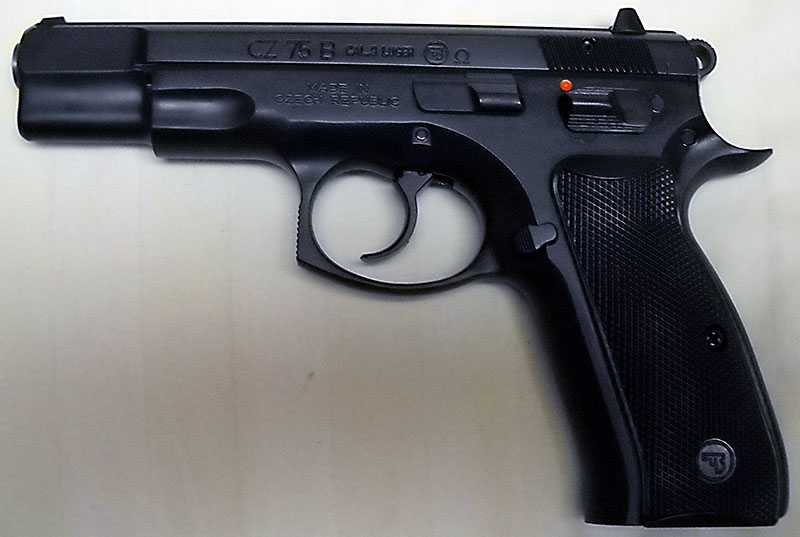
We've talked about the Czechoslovakian arms industry before. Under both Nazi occupation¹ during World War II and Soviet domination thereafter, the arms industry in Czechoslovakia (concentrated primarily in the part that is the present-day Czech Republic) kept to its own engineering idiom and its own standards of production. Cold War Czech arms designers would use the standard Soviet ammunition if they had to, but their factories didn't build clones of Soviet weapons the way most of the USSR's other satellite states did. Czechoslovak weapons were stubbornly their own.
Another thing that Czechoslovakia did a little differently from most other members of the Warsaw Pact was make things for export. Communism is all well and good, but hard currency, though forbidden to the citizenry, is very useful for the State to have. (Yugoslavia did this too—that's how we got the Yugo in the US—but then Yugoslavia wasn't part of the Warsaw Pact, which makes it even more of an oddball in the Cold War Communist world than Czechoslovakia.) To this end, in the late 1960s, engineers at Ceskáslovenská Zbrojovka (Czechoslovakian State Armament Works, or thereabouts) in Uherský Brod (not to be confused with the other Ceskáslovenská Zbrojovka in Brno) started work on a pistol aimed (as it were) at the export market.
Because it was meant for export, the new CZ pistol was developed from the start to chamber the German 9×19mm Parabellum cartridge, popular in the West, rather than 7.62×25mm Tokarev (then the Czechoslovakian Army's standard pistol cartridge) or 9×18mm Makarov (which would replace it). It was intended to be highly accurate and reliable, a service handgun with all modern conveniences. The result debuted in 1975 and was duly called the CZ 75.
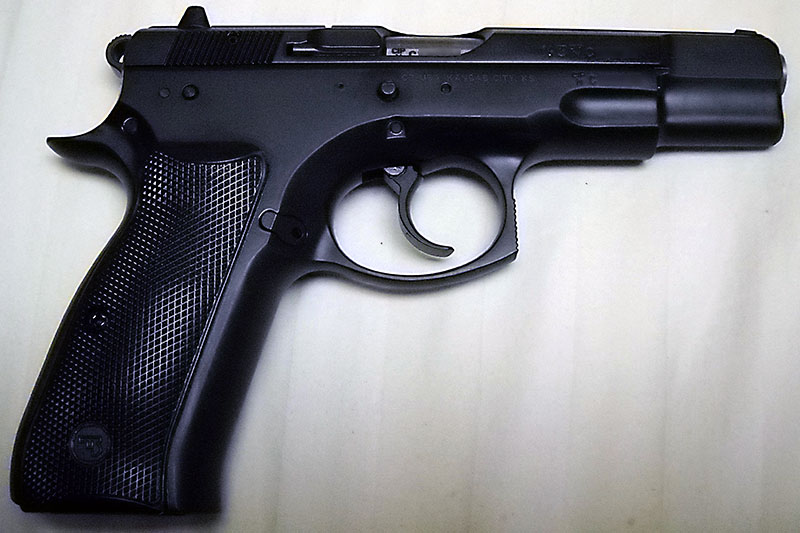
Here's where the story gets weird, because—with a very fine handgun that could have done extremely well for it in the West on its hands—the Czechoslovakian government rather shot itself in the foot. As it were. They classified the patents on the 75 as state secrets and forbade the factory to file for patent protection in any other country. Meanwhile, the US government applied a 60% tariff on imports from Czechoslovakia. This meant two things:
Clones of a pistol whose original form was not available appeared almost immediately. The 75 was knocked off by Tanfolio in Italy, Norinco in the People's Republic of China, Israeli Military Industries... you name it. Meanwhile, except for a handful of very highly prized grey-market collectors' imports, the real thing wasn't available in the US until after the fall of the Iron Curtain.
Mind you, since that point, the proliferation of clones hasn't hurt the CZ 75's market share terribly much. The B model (differentiated from the original version by longer slide rails and a less extravagantly stepped slide profile, as well as a couple of internal changes) is still in production today, and in a dizzying profusion of different sub-models and derivative types.
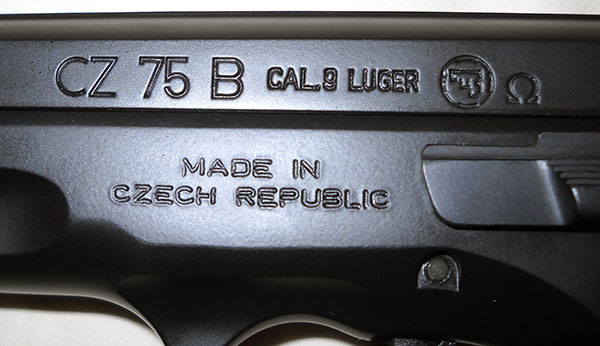
(Note how the gun in the company's logo is made of the letters UB. That's a nice touch.)
What we have here is a CZ 75B Ω, which is to say it's a standard all-steel B-model 75 with what CZ calls the "Omega" trigger package (a factory version of a custom trigger job). It's not one of the cutting-edge alloy- or polymer-framed versions, it doesn't have an integral accessory rail, it's not compensated or fitted with tritium night sights or optimized for competition. You can get 75s and 75 derivatives direct from CZ that are any (and in some cases more than one) of those things. Mine isn't any of them.
Before we get to looking at what sets the CZ 75B apart from other pistols, let's look at what it's similar to. Disassembling it alongside a gun we've already met, the mighty Browning Hi-Power, reveals some interesting similarities.
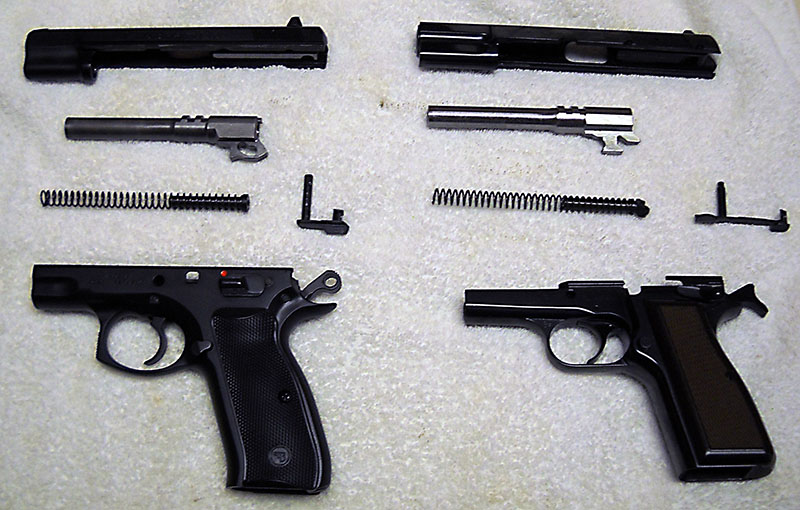
Yep! On the inside, the 75 is pretty much, well... a Hi-Power. A straight-up tilting-barrel, fixed-cam-linkage, Browning short-recoil action. Obviously all the parts are different, nothing is interchangeable between the two, but the similarity is striking. They even have similar magazines:
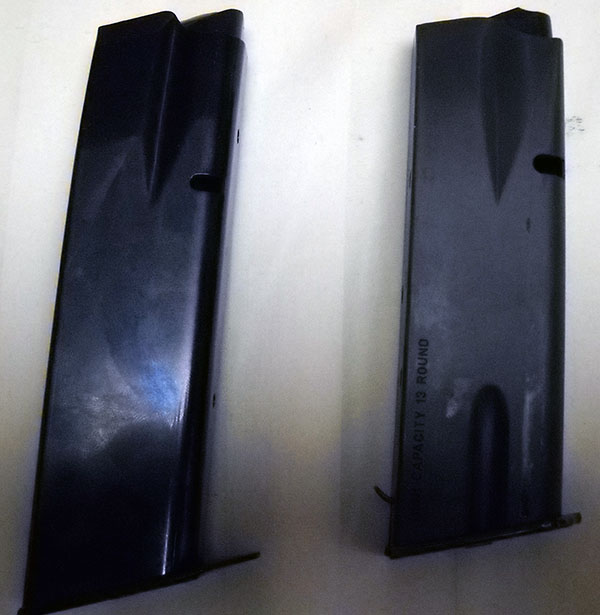
The 75B's magazine (left) holds 16 rounds of 9mm Parabellum ammunition, three more than the Hi-Power's. I assume this is mostly because the 75's grip, and thus the magazine that fits inside it, is longer, because otherwise they are virtually identical.
One significant difference between the two pistols is that where the Hi-Power is a classic single-action-only semi-auto, the 75 (in its standard form) has a double/single-action trigger. This means if it's loaded, charged, and then decocked, it can be fired with a long, heavy trigger pull for the first shot and short, light pulls for the subsequent ones. Which is fine, and not that unusual by 1975—the Walther P38 did that in 1938—except that the standard 75 does not have a decocking safety. Instead, the safety works just like the one on the Hi-Power: engaging it with the hammer cocked locks it and the trigger in place, keeping it from being fired.
This is a little odd, because although it means users can carry the pistol in what tactical shooting dudes call Condition One (or "cocked and locked"), putting it into Condition Two (loaded and charged, but with the hammer down, the usual carry state for double-action pistols) is a slightly dicey proposition. The hammer mechanism does have a half-cock notch (again, like the Hi-Power), but still, decocking a charged automatic manually is not for casuals.
CZ themselves appear to recognize that this is a bit strange, and so in recent years have offered the CZ 75BD sub-model, which has a decocking safety like a P38's rather than the Hi-Power-style one of the standard model. In fact, newer examples of the Omega version than the one we see here are labeled "Ω Convertible" and come with the parts to switch between B and BD mode.
That peculiarity notwithstanding, the 75B has really good ergonomics. The grip is substantial, particularly as it's so long, which makes it not very suitable for concealed carry, I should think, but admirably well-mannered for a service pistol. One feature of the CZ 75B that is very much of its time is its trigger guard, which is squared and checkered for the shooter's support hand index finger—de rigueur in the '70s and '80s, not so much nowadays.
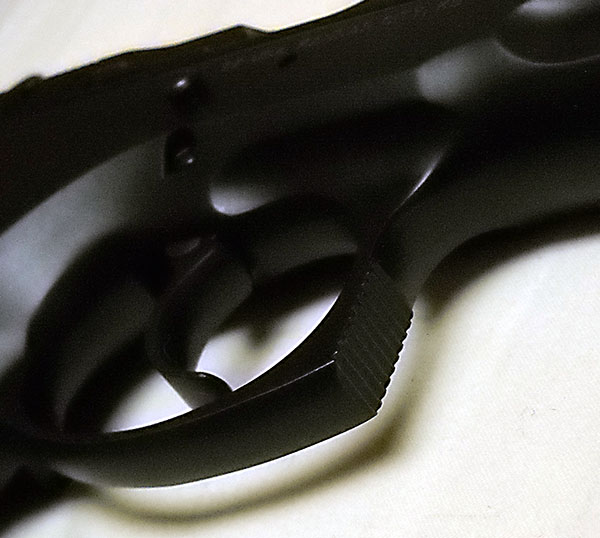
If I have a complaint about the 75's ergo (besides the right-handed safety, which it will not surprise you to learn is available in ambidextrous form on a sub-model), it's that the low-profile slide makes it a little harder to get hold of than on many another full-size auto. That low-profile slide has a purpose, though. Unlike many semi-autos, which have slides that ride on the outside of the frame rails, the 75's slide rides inside the rails. That makes it fit more tightly, and makes it less susceptible to wear, which improves the pistol's accuracy and longevity.² This is part of why CZ 75s have long been popular with competitive precision shooters.
Takedown is similar to the Hi-Power, except (in my opinion) not as good. Since the 75's safety lever can't be used as a slide lock like the Hi-Power's, the second step of disassembly (after clearing the pistol, of course) instead involves taking hold of it in a somewhat awkward grip and aligning marks on the slide and frame, thusly:
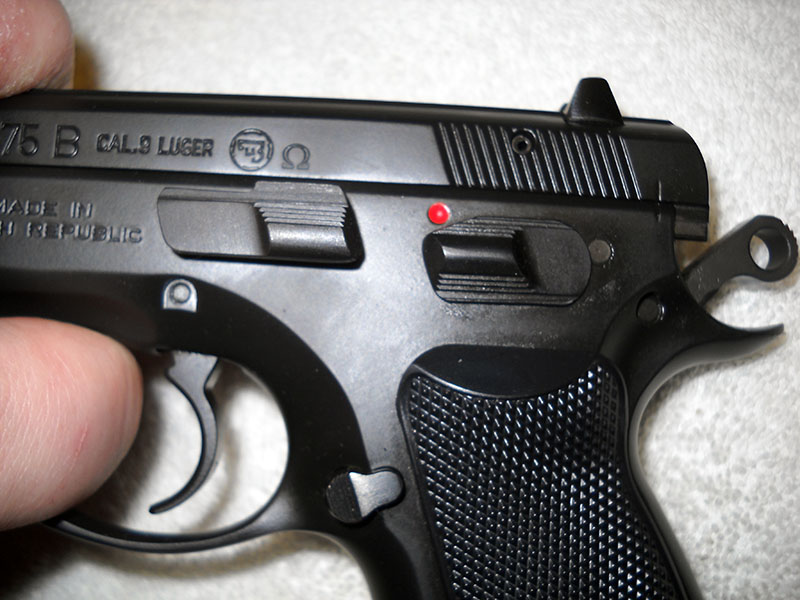
You can then finagle the crosspin out of the pistol, as with a Hi-Power, after which the slide comes off the front and the spring and barrel can be removed from it in just the same way. The pin removal is made to seem absurdly easy in the company's own little how-to video about field-stripping a 75B, but on this, one, at least, it is insanely stiff and difficult to remove. Maybe that's just because the gun is brand new, I'm not sure, but there it is.
It's unfortunate, though, because removing the slide is something that can need to be done to one of these pistols fairly often. Not only is field-stripping necessary for proper cleaning, it's also how you install a nifty accessory CZ makes available for the 75: a little package called the Kadet II.
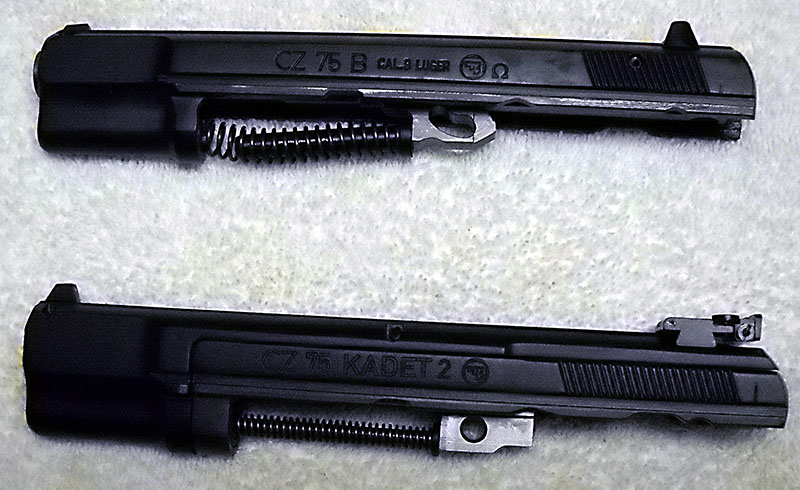
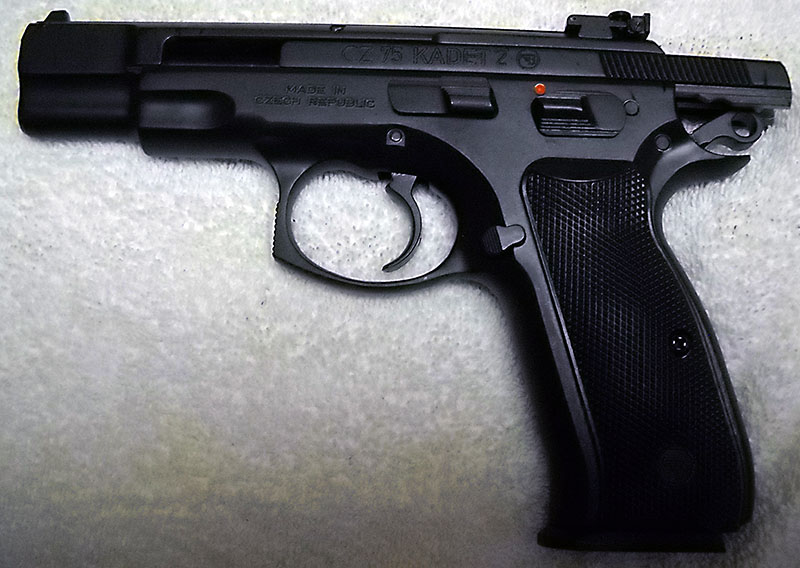
As you see, the Kadet II is a replacement for the CZ 75's slide, barrel, and recoil spring. It adds an adjustable, match-type rear sight and converts the pistol from 9mm Parabellum to .22 Long Rifle, giving the owner a .22 target pistol with exactly the same grip, controls, and reloading dynamics as the original.
Functionally, the Kadet is a simple blowback system (it doesn't need to be anything more elaborate for .22 rimfire). Only part of it is the .22 version's actual slide; the rest is just there to provide mass, profile, containment, and someplace for the sights to sit.
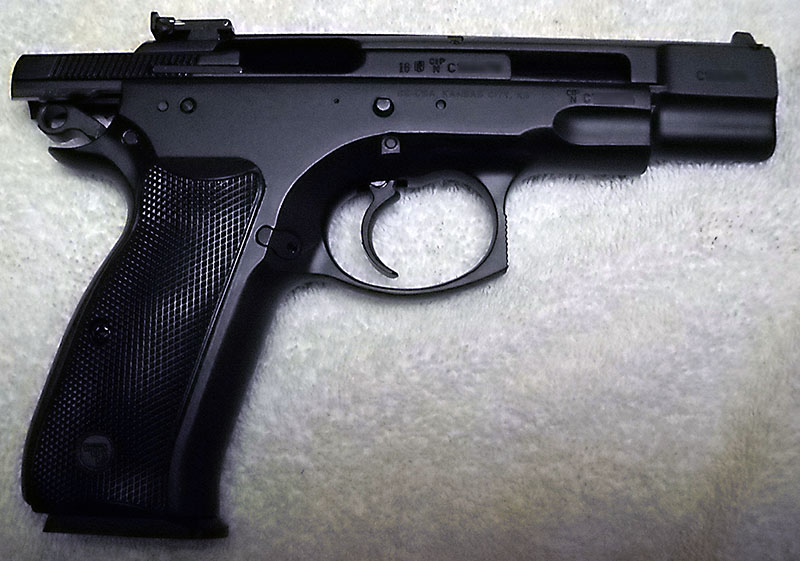
Although it uses the 75's entire frame and trigger mechanism, obviously the Kadet needs different magazines. They're the same external size as the originals, since they have to fit the same magazine well and release, but internally they're single-stack magazines holding 10 rounds.
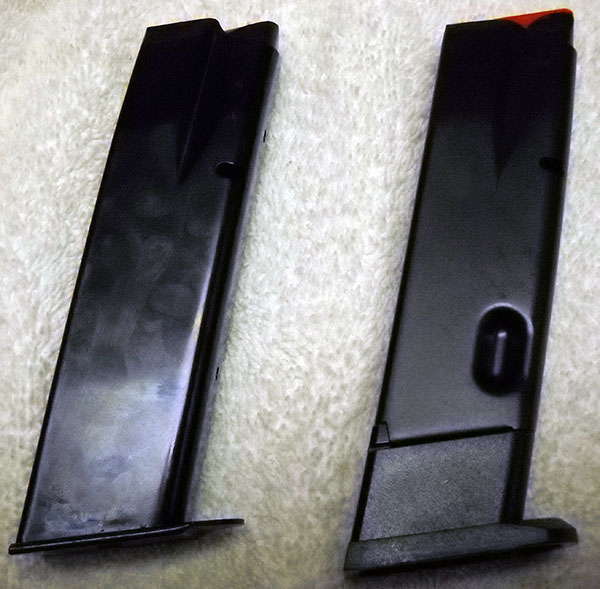
Outside the gun, they're easily distinguished by their feed geometry and specially-colored followers.
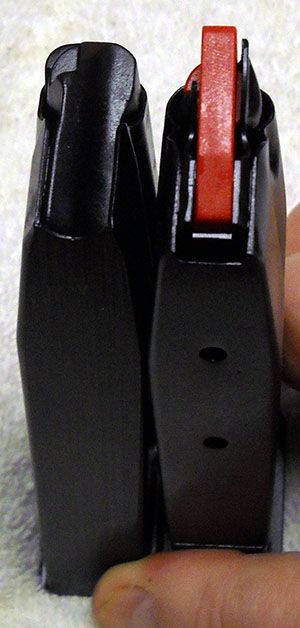
The Kadet II is billed as a drop-in replacement for the 75's slide, but the manual warns that a little bit of gunsmithing may be required to make a given Kadet work smoothly with a given 75. That seems to be true of mine; I can install it, but it doesn't fit smoothly. I'll have to get them to a proper gunsmith for fine-tuning before I try to shoot it (and maybe he can do something about the annoying difficulty of taking the piece apart in the first place).
In popular culture, folks in these parts are likely to recognize the CZ 75 from Gunsmith Cats, where it features prominently as Rally Vincent's sidearm of choice. There's a whole subplot in one volume of the manga about what a pistol snob Rally is. She declines to use the (readily available after 1992) B-model, insisting instead on the original short-rails version. Since this model was, as far as I know, never legally exported to the United States, examples are ridiculously rare and valuable here, so much so that Rally's second choice, which she will grudgingly deign to employ when she can't find an original-version 75 to replace the last one that got destroyed by her high-risk lifestyle, is a SIG P210.
For context, the P210 is a Swiss 9mm service pistol that is ridiculously expensive not because it's rare, but because it's Swiss. It's one of the relatively few other inside-the-rails designs, and is known for being a finely made match-grade target pistol despite the fact that it was made for and adopted by the Swiss Army (and I believe also that of Denmark). The cheapest P210 they have at Simpson Ltd. right now has a damaged bore and still costs $2,500. Rally considers it... acceptable. This is presumably a big part of why Rally is flat-ass broke most of the time. She's the gun shop equivalent of a coke dealer who snorts his own stash. :)
--G.
¹ The Germans held Czech weapons in such high regard that they readily adopted them for their own use rather than force Czech plants to produce German designs; any Wehrmacht weapon you see with a "(t)" in its designation is of Czech (in German, tschechisch) origin.
² Outside-the-rails pistols' slides tend to stretch with time and wear, loosening their hold on the rails. This was the notorious problem with the U.S. Army's war-weary M1911A1s in the '70s and '80s that led to the "slide squeeze" fix that had such unfortunate side effects when applied to the new M9s.